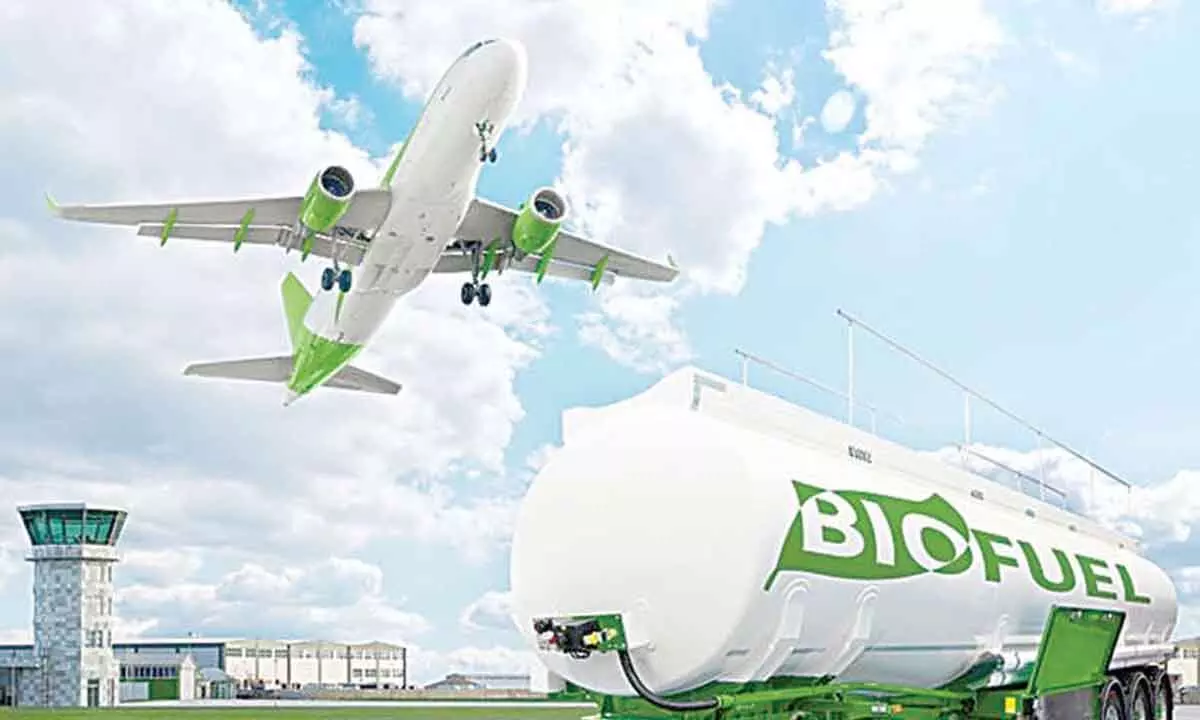Live
- They always want me to win, and now I feel lucky to have been offered a story like ‘Zebra’: Satyadev Kancharana
- ‘Democracy first, humanity first’: PM Modi in Guyana's parliament on two countries' similarities
- PKL Season 11: Telugu Titans register third straight win to top standings
- Is Pollution Contributing to Your COPD?
- NASA Unveils Underwater Robots for Exploring Jupiter's Moons
- Additional Central forces arrive in violence-hit Manipur
- AR Rahman and Saira Banu’s Divorce: Legal Insights into Common Issues in Bollywood Marriages
- 82.7 pc work completed in HPCL Rajasthan Refinery area: official
- Curfew relaxation extended in 5 Manipur districts on Friday
- Tab scam prompts Bengal govt to adopt caution over fund disbursement
Just In
SAF will remain key renewable fuel for aviation industry


Global forecast for renewable fuel production, including SAF, shows a regional distribution
Sustainableaviation fuel (SAF) accounted for three per cent of all renewable fuels produced, with 97 per cent of renewable fuel production going to other sectors. The SAF production is expected to triple to 1.875 billion liters (1.5Mt), this year accounting for 0.53 per cent of aviation’s fuel need and 6 per cent of renewable fuel capacity. In 2023, SAF volumes reached over 600 million liters (0.5Mt), double the 300 million liters (0.25 Mt) produced in 2022.
The small percentage of SAF output as a proportion of overall renewable fuel is primarily due to the new capacity coming online in 2023 being allocated to other renewable fuels.
“The doubling of SAF production in 2023 was encouraging as is the expected tripling of production expected in 2024. But even with that impressive growth, SAF as a portion of all renewable fuel production will only grow from 3 per cent this year to 6 per cent in 2024. This allocation limits SAF supply and keeps prices high.
Aviation needs between 25 per cent and 30 per cent of renewable fuel production capacity for SAF. At those levels aviation will be on the trajectory needed to reach net zero carbon emissions by 2050. Until such levels are reached, we will continue missing huge opportunities to advance aviation’s decarbonization.
It is government policy that will make the difference. Governments must prioritize policies to incentivize the scaling-up of SAF production and to diversify feed stocks with those available locally,” said Willie Walsh, IATA Director General.
Global forecast for renewable fuel production (not just SAF) shows a regional distribution of production. At present we estimate a potential output of 63 Mt from renewable fuel projects which have slated SAF as a potential output. This should increase in the coming years, but it is also true some of these projects will fail. If we assume a 30 per cent production channeled towards SAF (an assumption which is aligned to optimal refining for the HEFA pathway) the outputs could actually match today’s 2030 projections on the regional policies slide, about 10 Mt in North America, about 5 Mt in Europe, about 2 Mt in APAC.
While planned capacity generally matches forecast demand as of today, actual SAF output will greatly depend on supportive policies vs. other renewable fuels.
If a country has incentives on renewable diesel and not for SAF, more of the output from the producer will be channeled to the renewable diesel and not to SAF for aviation. We need balanced policies for renewable fuels to ensure a fair output of SAF.
So far the focus has been on demand vs production to 2030. Aviation’s commitment for net zero carbon emissions by 2050 means we will need around 20 times as much SAF in 2050 compared to 2030.
SAF is the biggest lever for aviation’s transition to net zero carbon emissions. But this key solution for aviation also offers broader benefits positively impacting sustainability, economic opportunity and energy security. Projects that are aimed at aggregating wastes or re-cultivating degraded land have several positive socio-economic effects which become a major pull factor for attracting institutional and critically, government investment. Governments should be encouraged and supportive of projects because of the potential to: Develop sustainable supply chains at the regional level; Create of local income and employment; Support land restoration and/or regeneration; Promote and foster biodiversity; and Aiding the development of localized energy independence and security.
In India, Praj has developed a proprietary technology to process agricultural feed stocks for the production of SAF that can be blended with aviation turbine fuel (ATF).
Pramod Chaudhari, executive chairman, Praj Industries said, “Inauguration of SAF demonstration facility is yet another milestone in Praj’s pursuit of energy transition through Bioeconomy. Recently, we collaborated with IOCL and AirAsia India to successfully fly India’s first commercial passenger flight with 1 per cent SAF produced at our bench scale setup that was blended with ATF.
We believe in India’s potential to be a hub for supplying SAF for the Global Aviation Industry and we stand committed to helping build SAF production capacities.
It may be noted that around 3 per cent of all GHG emissions worldwide are currently attributable to aviation. Unless controlled, otherwise the emissions may zoom to as much as 22 per cent of global greenhouse gas emissions.

© 2024 Hyderabad Media House Limited/The Hans India. All rights reserved. Powered by hocalwire.com






